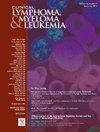血液学恶性肿瘤危重期患者侵袭性真菌病的临床特征、危险因素和预后:回顾性研究
IF 2.7
4区 医学
Q2 HEMATOLOGY
引用次数: 0
摘要
背景:侵袭性真菌病(IFD)对血液系统恶性肿瘤(HMs)危重患者提出了重大挑战。然而,在这一人群中,对IFD的临床特征、危险因素和结果的研究有限。方法:在中国某三级医疗中心进行回顾性研究。该研究的重点是2014年至2022年间入住重症监护病房(ICU)的HMs患者。结果:239例患者入组,其中105例(43.9%)诊断为IFD。进一步分类显示,64.8%、31.4%和3.8%分别为可能、可能和已证实的IFD。与没有IFD的患者相比,IFD患者在ICU的住院时间明显延长(中位数:4.9天vs 2.9天,P < 0.001)。值得注意的是,有无IFD患者的28天死亡率无统计学差异(44.8% vs. 54.5%, P = .907)。高血压、机械通气(MV)持续时间超过48小时、病情恶化至入住ICU间隔时间延长是IFD的独立危险因素。结论:IFD是HM危重患者常见的并发症,与ICU住院时间延长有关。此外,高血压、MV持续时间延长和ICU转移延迟是这些患者发生IFD的独立危险因素。本文章由计算机程序翻译,如有差异,请以英文原文为准。
Clinical Characteristics, Risk Factors and Outcomes of Invasive Fungal Disease in Critically III Patients with Hematological Malignancy: A Retrospective Study
Background
Invasive fungal disease (IFD) poses significant challenges for critically ill patients with hematological malignancies (HMs). However, there is limited research on the clinical characteristics, risk factors, and outcomes of IFD within this population.
Method
A retrospective study was conducted at a tertiary center in China. The study focused on patients with HMs admitted to the intensive care unit (ICU) between 2014 and 2022.
Results
A total of 239 patients were enrolled, among whom 105 (43.9%) were diagnosed with IFD. Further classification revealed that 64.8%, 31.4%, and 3.8% were classified as possible, probable, and proven IFD, respectively. Patients with IFD had significantly prolonged ICU stays compared to those without IFD (median: 4.9 vs. 2.9 days, P < .001). Notably, there was no statistically significant difference in 28-day mortality between the patients with and without IFD (44.8% vs. 54.5%, P = .907). Hypertension, mechanical ventilation (MV) duration exceeding 48 hours, and an extended interval between deterioration and ICU admission emerged as independent risk factors for IFD.
Conclusion
IFD is a common complication in critically ill patients with HM and is associated with prolonged length of ICU stay. Additionally, hypertension, prolonged MV duration and delayed ICU transfer are independent risk factors of IFD in these patients.
求助全文
通过发布文献求助,成功后即可免费获取论文全文。
去求助
来源期刊

Clinical Lymphoma, Myeloma & Leukemia
ONCOLOGY-HEMATOLOGY
CiteScore
2.70
自引率
3.70%
发文量
1606
审稿时长
26 days
期刊介绍:
Clinical Lymphoma, Myeloma & Leukemia is a peer-reviewed monthly journal that publishes original articles describing various aspects of clinical and translational research of lymphoma, myeloma and leukemia. Clinical Lymphoma, Myeloma & Leukemia is devoted to articles on detection, diagnosis, prevention, and treatment of lymphoma, myeloma, leukemia and related disorders including macroglobulinemia, amyloidosis, and plasma-cell dyscrasias. The main emphasis is on recent scientific developments in all areas related to lymphoma, myeloma and leukemia. Specific areas of interest include clinical research and mechanistic approaches; drug sensitivity and resistance; gene and antisense therapy; pathology, markers, and prognostic indicators; chemoprevention strategies; multimodality therapy; and integration of various approaches.
 求助内容:
求助内容: 应助结果提醒方式:
应助结果提醒方式:


